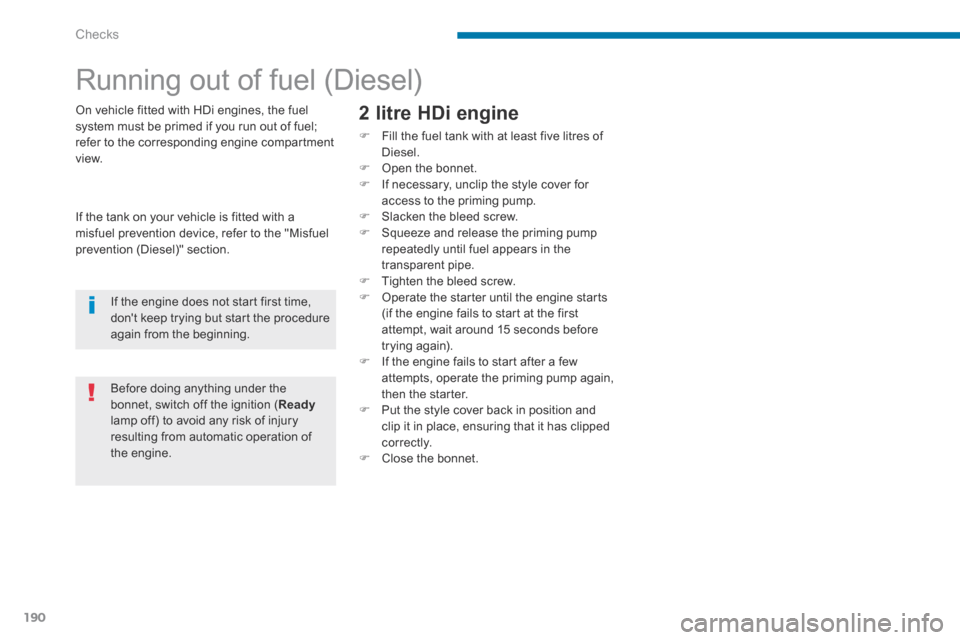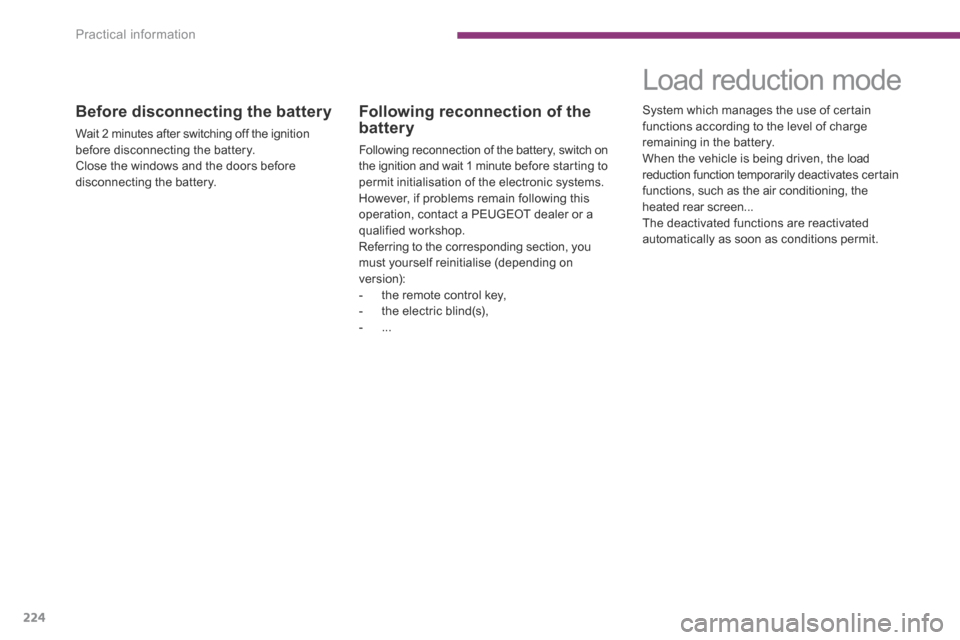Page 192 of 378

Checks
190
Running out of fuel (Diesel)
2 litre HDi engine
Fill the fuel tank with at least five litres of Diesel. Open the bonnet. If necessary, unclip the style cover for access to the priming pump. Slacken the bleed screw. Squeeze and release the priming pump repeatedly until fuel appears in the transparent pipe. Tighten the bleed screw. Operate the starter until the engine starts (if the engine fails to start at the first attempt, wait around 15 seconds before trying again). If the engine fails to start after a few attempts, operate the priming pump again, then the starter. Put the style cover back in position and clip it in place, ensuring that it has clipped
c o r r e c t l y. Close the bonnet.
On vehicle fitted with HDi engines, the fuel system must be primed if you run out of fuel; refer to the corresponding engine compartment view.
If the tank on your vehicle is fitted with a
misfuel prevention device, refer to the "Misfuel prevention (Diesel)" section.
Before doing anything under the bonnet, switch off the ignition ( Readylamp off) to avoid any risk of injury resulting from automatic operation of the engine.
If the engine does not start first time, don't keep trying but start the procedure again from the beginning.
Page 194 of 378

Checks
192
Checking levels
Engine oil level
The check is carried out either when the ignition is switched on using the oil level indicator in the instrument panel for vehicles with and electric oil level gauge, or using the dipstick.
Check all of these levels regularly, in line with the warranty and maintenance record. Top them up if necessary, unless other wise indicated. If a level drops significantly, have the corresponding system checked by a PEUGEOT dealer or a qualified workshop.
To ensure that the reading is correct, your vehicle must be on level ground and the engine has been off for more than 30 minutes.
It is normal to top up the oil level between two services (or oil changes). PEUGEOT recommends that you check the level, and top
up if necessary, every 3 000 miles (5 000 kms).
Take care when working under the bonnet, as certain areas of the engine may be extremely hot (risk of burns) and the cooling fan could start at any time (even with the ignition off).
Before doing anything under the bonnet, switch off the ignition ( Ready lamp off) to avoid any risk of injury resulting from automatic operation of
the engine.
Checking using the dipstick
Refer to the "Diesel engine" section for the location of the dipstick in the engine compartment of your vehicle. - Take the dipstick by its coloured grip and remove it completely. - Wipe the end of the dipstick using a clean non-fluffy cloth. - Refit the dipstick and push fully down, then pull it out again to make the visual check: the correct level is between the marks Aand B .
A = MA X
B = MIN
If you find that the level is above the A mark or below the B mark, do not star t the engine . - If the level is above the MAX mark (risk of damage to the engine), contact a PEUGEOT dealer or a qualified workshop.
- If the level is below the MIN mark, you must top up the engine oil.
Page 216 of 378

Practical information
214
Access to the tools Changing a fuse
GoodFailed
Use the special tweezer to extract the fuse from its housing. Always replace the faulty fuse with a fuse of the same rating. Check that the number etched on the box, the rating etched on the fuse and the tables below all agree.
Before changing a fuse, the cause of the failure must be identified and rectified. Identify the faulty fuse by checking the condition of its filament.
Changing a fuse
PEUGEOT will not accept responsibility for the cost incurred in repairing your
vehicle or for rectifying malfunctions resulting from the installation of accessories not supplied and not recommended by PEUGEOT and not installed in accordance with its instructions, in particular when the combined consumption of all of the additional equipment connected exceeds 10 milliamperes.
Installing electrical accessories
Your vehicle's electrical system is designed to operate with standard or optional equipment. Before installing other electrical equipment or accessories on your vehicle, contact a PEUGEOT dealer or a qualified workshop.
The replacement of a fuse not mentioned in the tables below could cause a serious malfunction on your vehicle. Contact a PEUGEOT dealer or a qualified workshop.
Procedure for replacing a faulty fuse with a new fuse to rectify a failure of the corresponding function.
The fuse extraction tweezer is fitted to the back of the dashboard fusebox cover. To gain access to it: Remove the cover completely. Remove the tweezer.
Page 220 of 378
Practical information
218
Engine compartment fuses
Access to the fuses
Unclip the cover. Change the fuse (see corresponding paragraph). When you have finished, close the cover carefully to ensure correct sealing of the fusebox.
The fusebox is placed in the engine compartment near the battery. Fuse N° Rating (A) Functions
F215 Horn.
F310 Front / rear wash-wipe.
F410 Daytime running lamps.
F515
Air flow sensor, wiper, sensor heater, hybrid control unit, hybrid selector dial, electronic thermostat, variable valve timing electrovalves, turbo pressure regulation electrovalves (Diesel), engine coolant level sensor (Diesel).
F610 Diagnostic socket, directional headlamps, particle emission filter pump (Diesel), mirror adjustment control, network inter face unit, head-up display.
F710 Power steering control unit, directional headlamps height adjustment motor.
F820 Starter motor control.
F910 Clutch and brake pedal switches.
F1140 Air conditioning blower.
Page 226 of 378

Practical information
224
Before disconnecting the battery
Wait 2 minutes after switching off the ignition before disconnecting the battery. Close the windows and the doors before disconnecting the battery.
Following reconnection of the battery
Following reconnection of the battery, switch on the ignition and wait 1 minu te before star ting to permit initialisation of the electronic systems. However, if problems remain following this operation, contact a PEUGEOT dealer or a qualified workshop. Referring to the corresponding section, you must yourself reinitialise (depending on version): - the remote control key, - the electric blind(s), - ...
Load reduction mode
System which manages the use of certain functions according to the level of charge remaining in the battery. When the vehicle is being driven, the load reduction function temporarily deactivates cer tain functions, such as the air conditioning, the heated rear screen... The deactivated functions are reactivated automatically as soon as conditions permit.
Page 228 of 378
Practical information
226
Changing a wiper blade
Removing
Raise the corresponding wiper arm. Unclip the wiper blade and remove it.
Fitting
Put the corresponding new wiper blade in place and clip it. Fold down the wiper arm carefully.
Before removing a front
wiper blade
Within one minute after switching off the ignition, operate the wiper stalk to position the wiper blades vertically on the windscreen.
After fitting a front wiper
blade
Switch on the ignition. Operate the wiper stalk again to park the wiper blades.
Page 237 of 378
12
Technical data235
Range varies according to the ambient climatic conditions, the driving style and conditions, the use of vehicle systems and ageing of the battery.
Electric motor and battery
Electric motor-
Technology Synchronous with permanent magnets.
Max. power: EU standard (kW) * 2 7
Max. power speed (rpm) 2 5 0 0
Max. torque: EU standard (Nm) 2 0 0
Max. torque speed (rpm) 1 2 5 0
Efficiency (%) 80 to 90
High voltage batteryNi-MH (Nickel Metal Hydride)
Voltage (V~) 2 0 0
Energy capacity (kWh / Ah) 1.1 / 5.5
Range (miles (km)) 1.2 (2) (approximately)
* The maximum power corresponds to the value type approved on an engine test bed, under conditions defined by European legislation (directive 1999/99/EC).
Page 238 of 378
Technical data
236
Engine2 litre Turbo HDi 163 hp
Gearbox Electronic (6-speed)
Cubic capacity (cc) 1 9 9 7
Bore x stroke (mm) 85 x 88
Max power: EU standard (kW) * 1 2 0
Max power engine speed (rpm) 3 8 5 0
Max torque: EU standard (Nm) 300
Max torque engine speed (rpm) 1 7 5 0
Fuel Diesel
Catalytic converter yes
Particle emission filter yes
Oil capacities (in litres)
Engine (with filter replacement) -
Gearbox - Final drive -
Diesel engines and gearboxes
* The maximum power corresponds to the type approved value on a test bed, under the conditions defined by European legislation (directive 1999/99/CE).